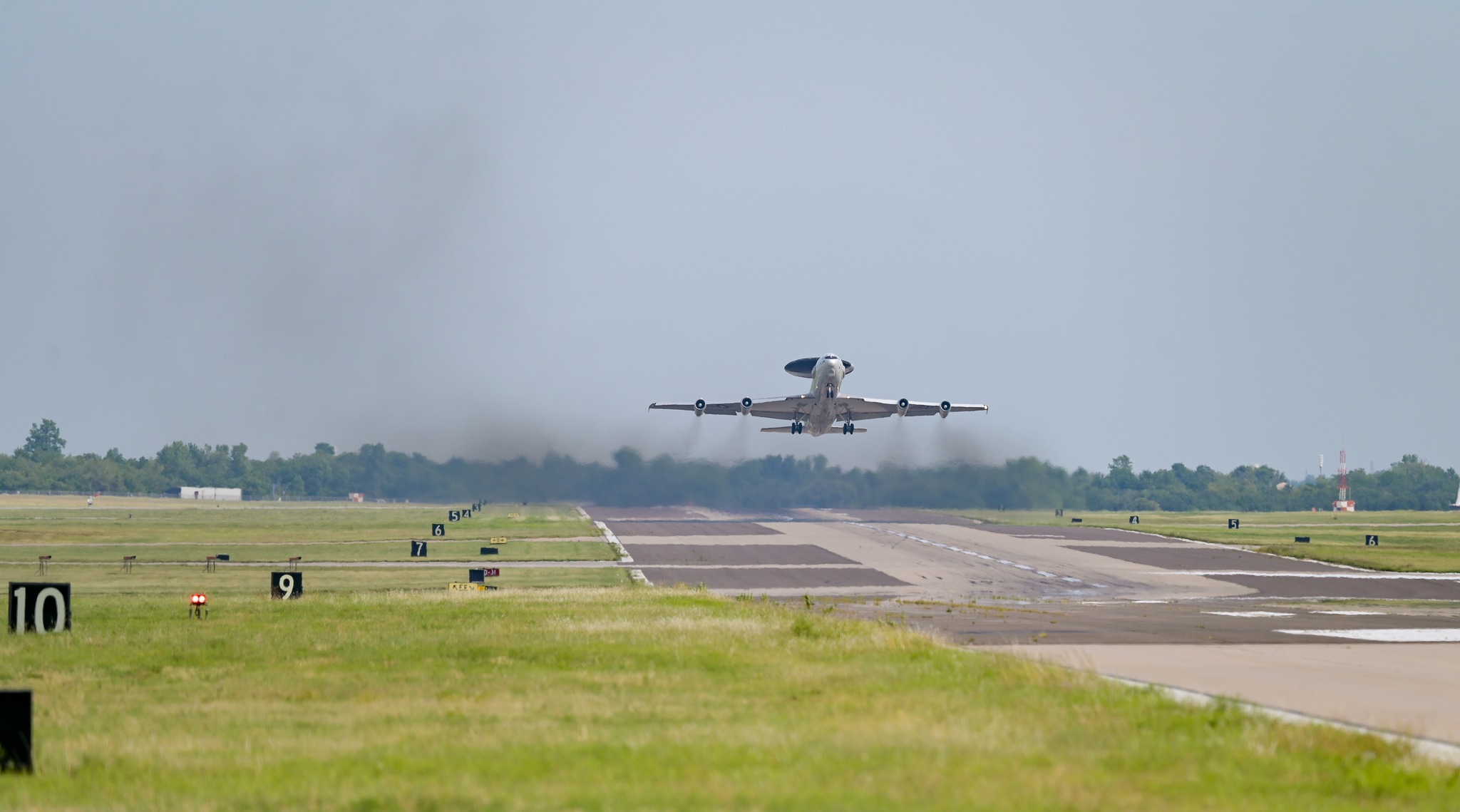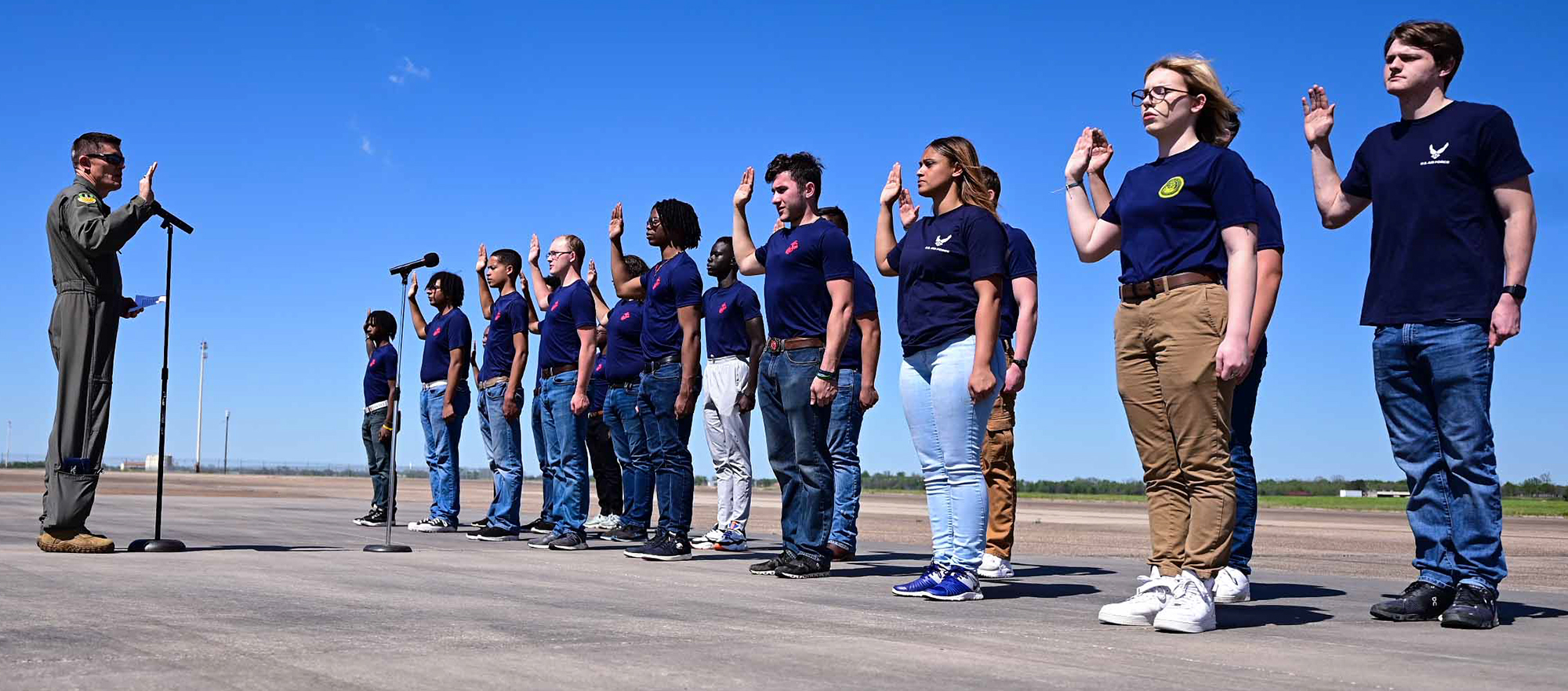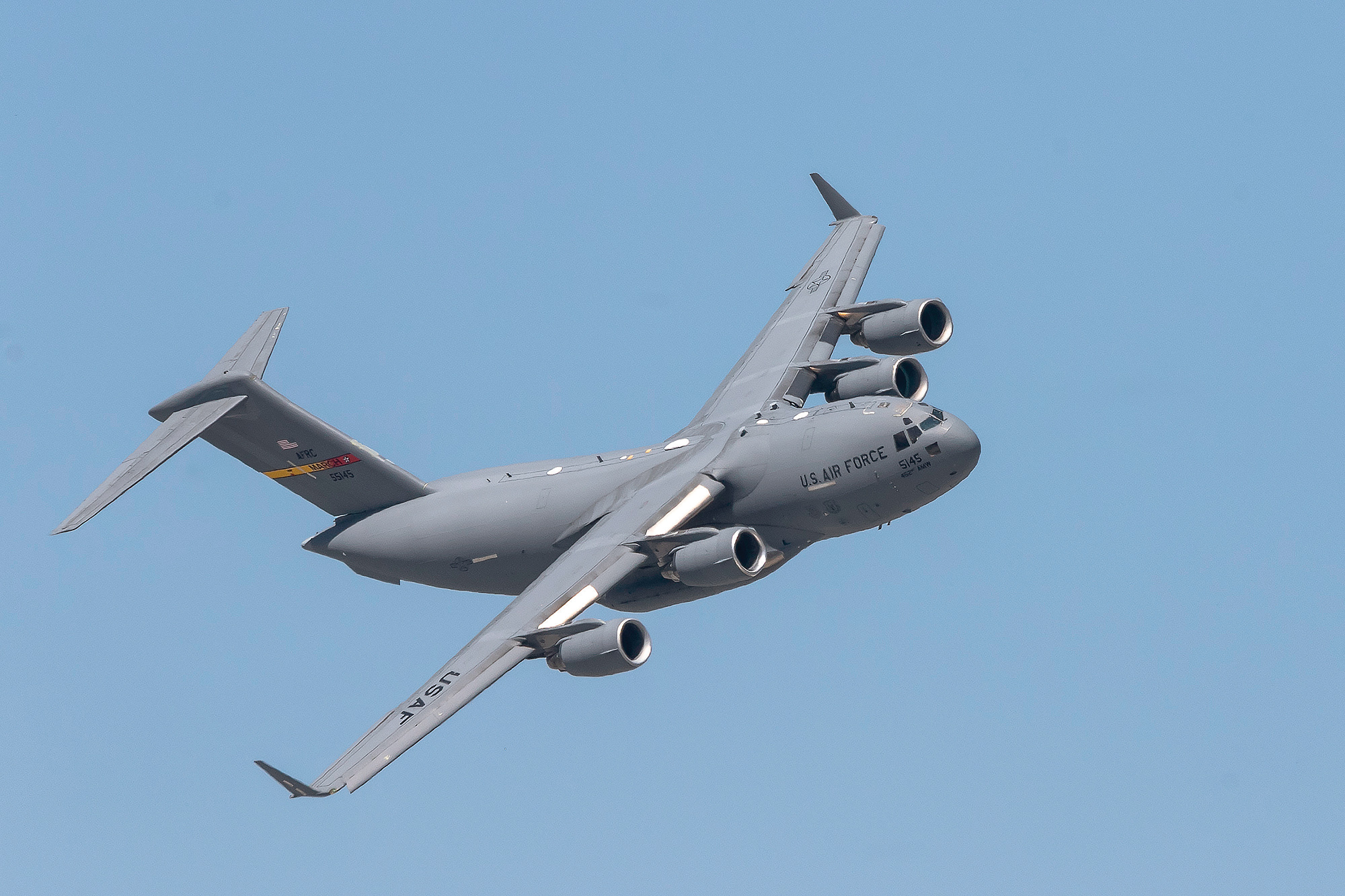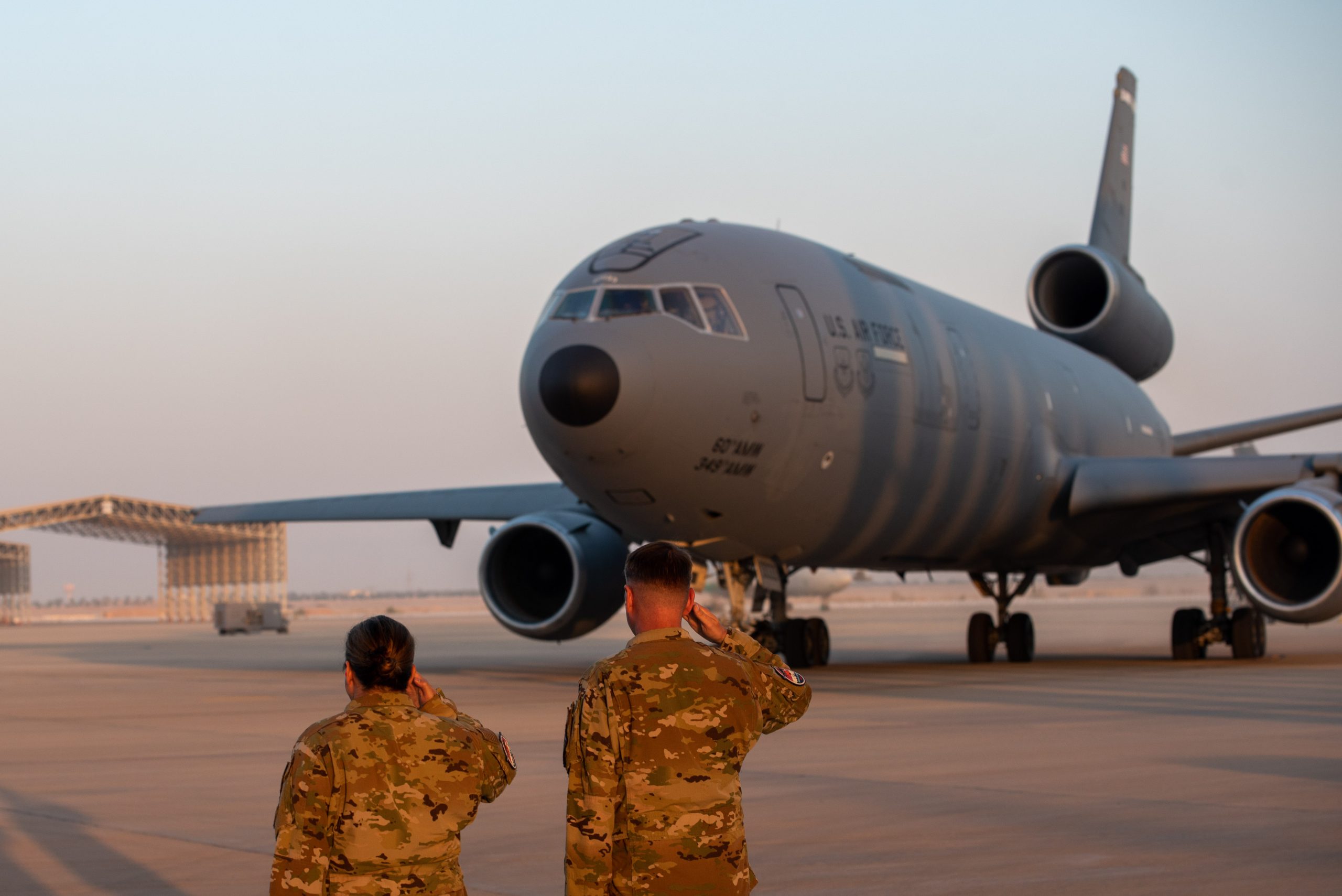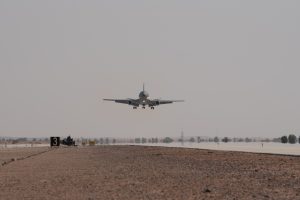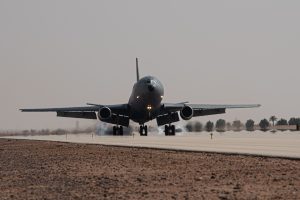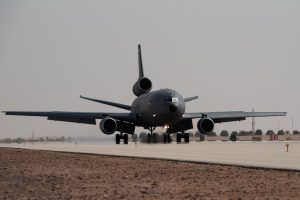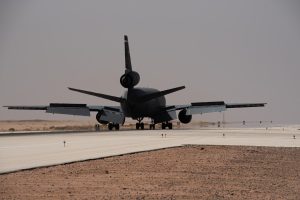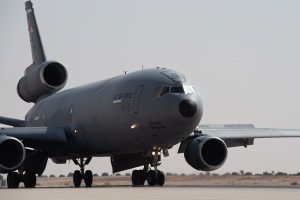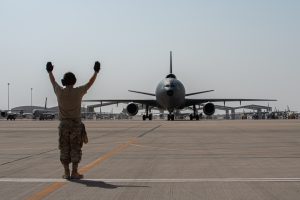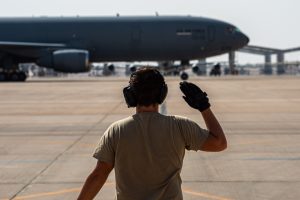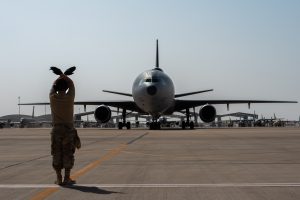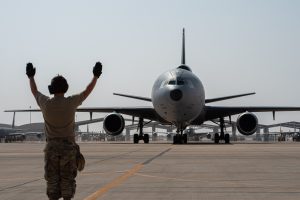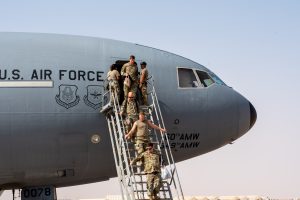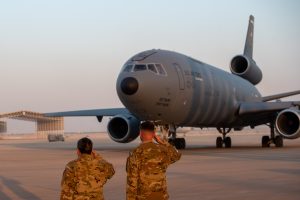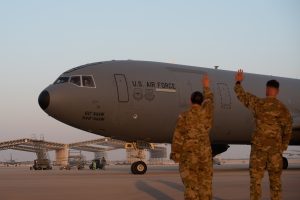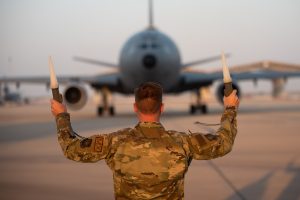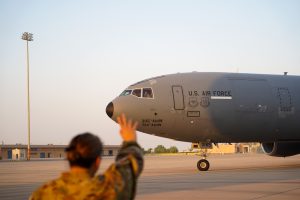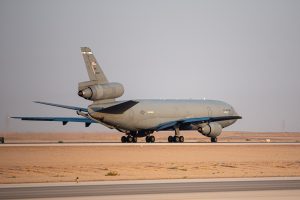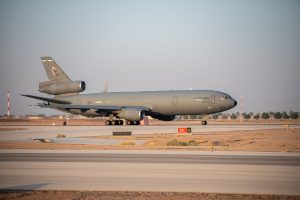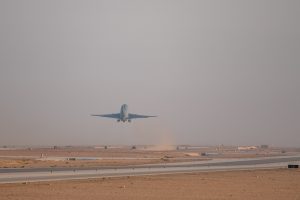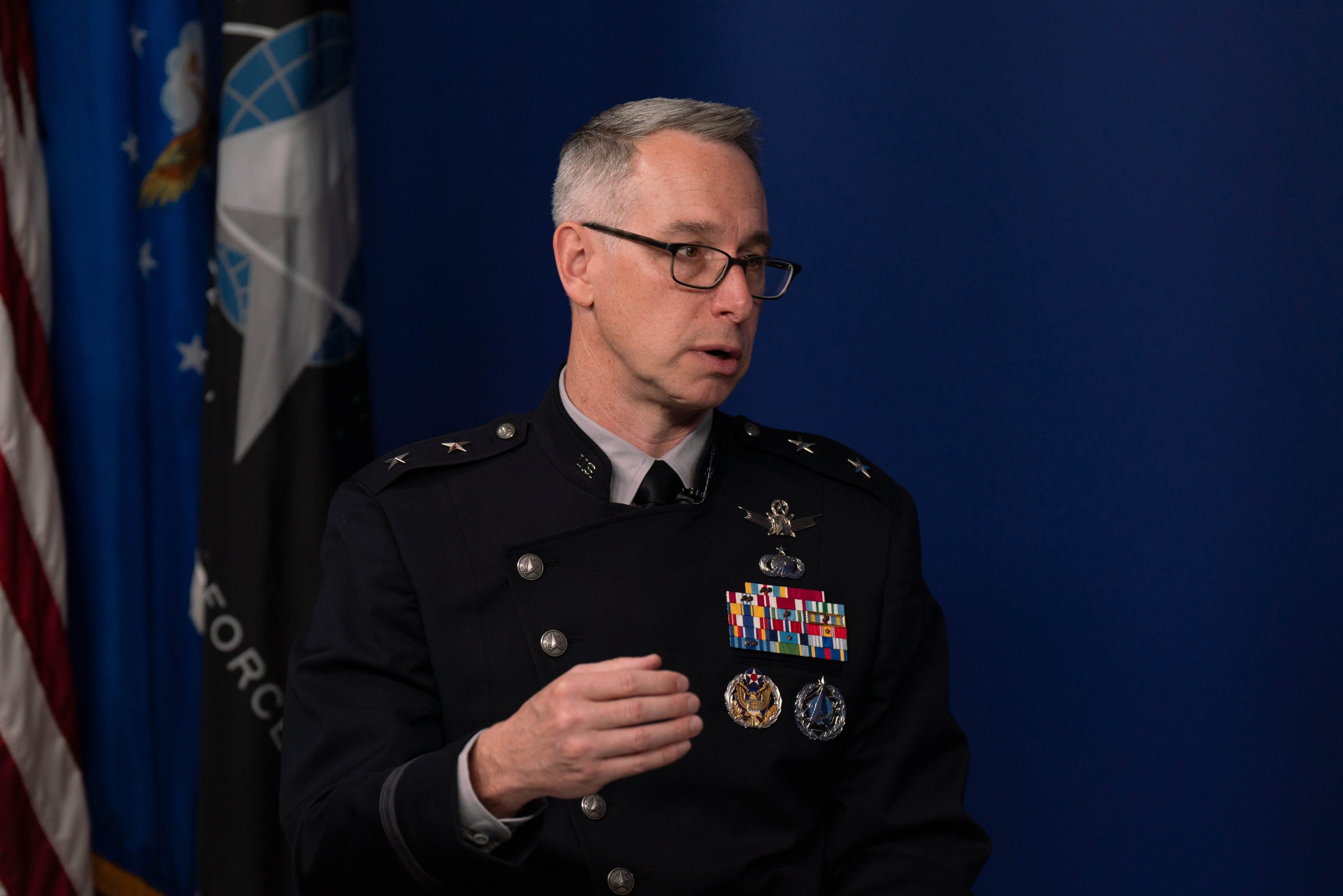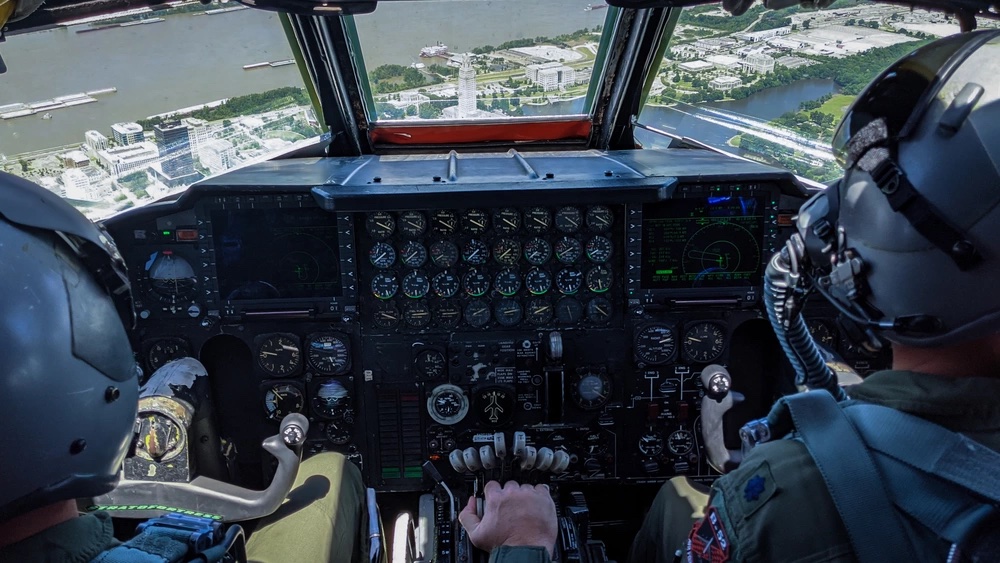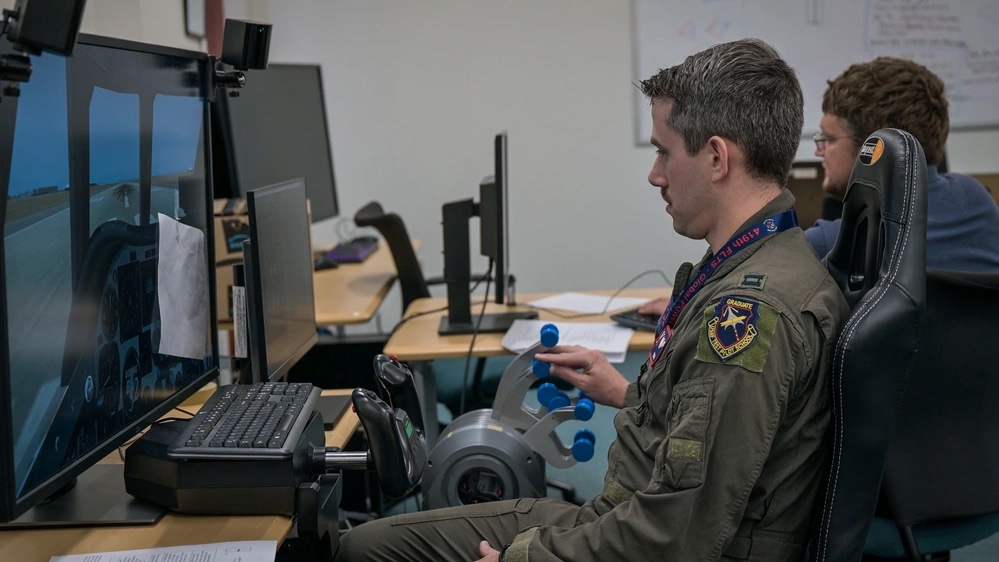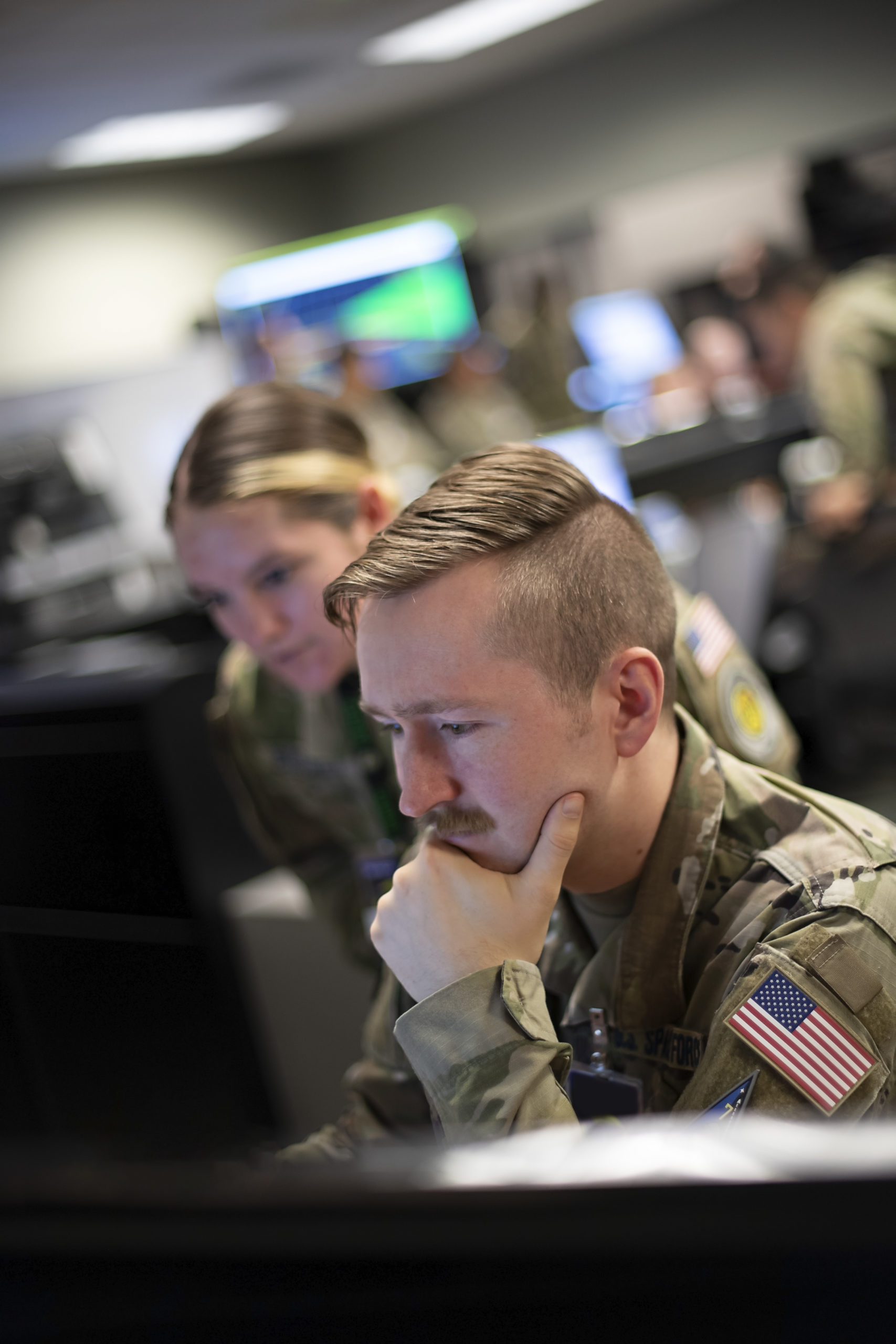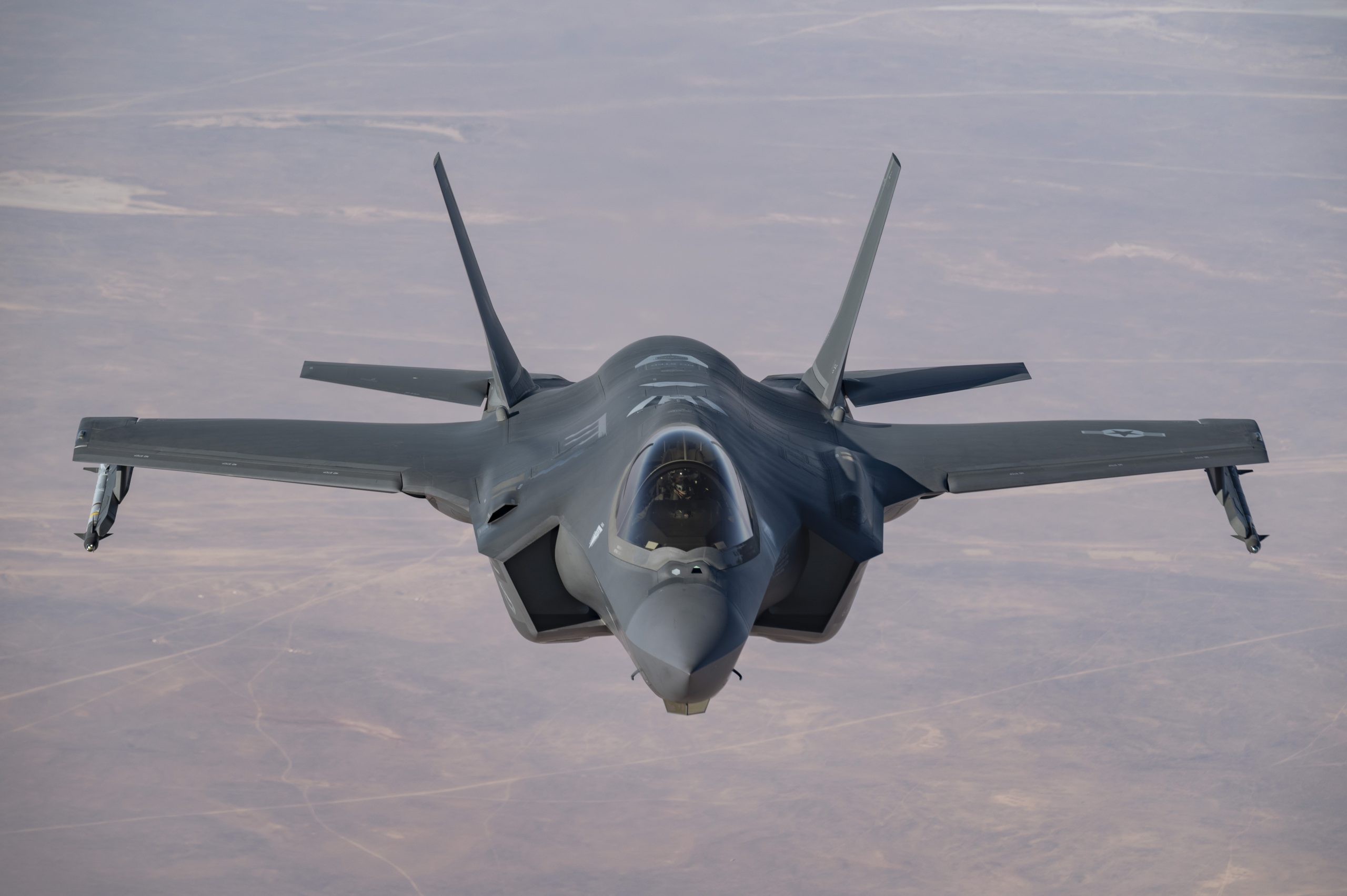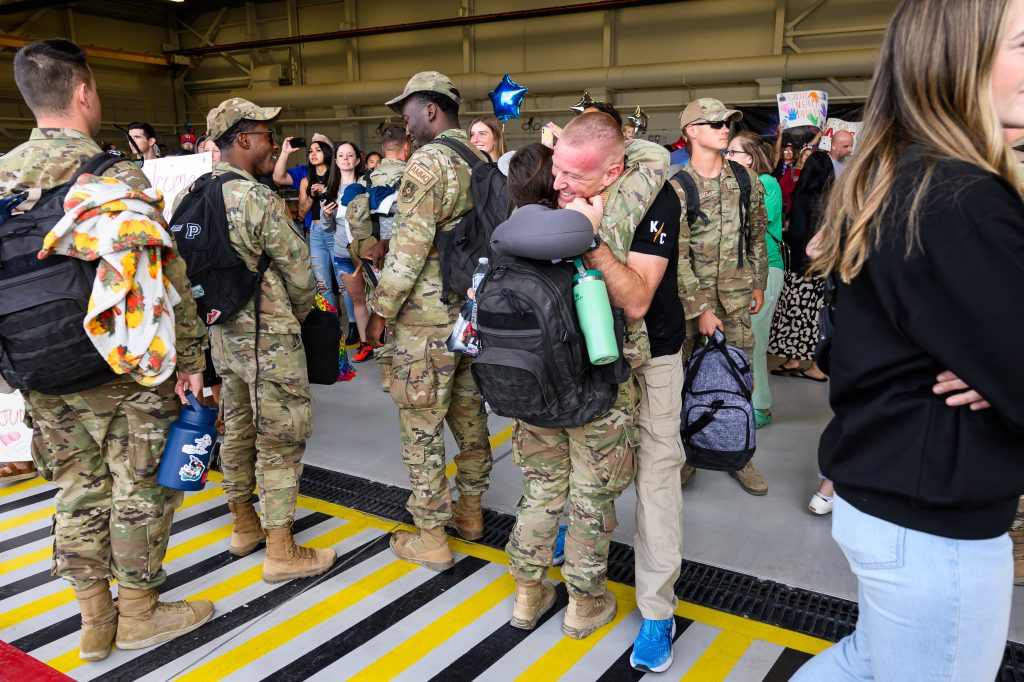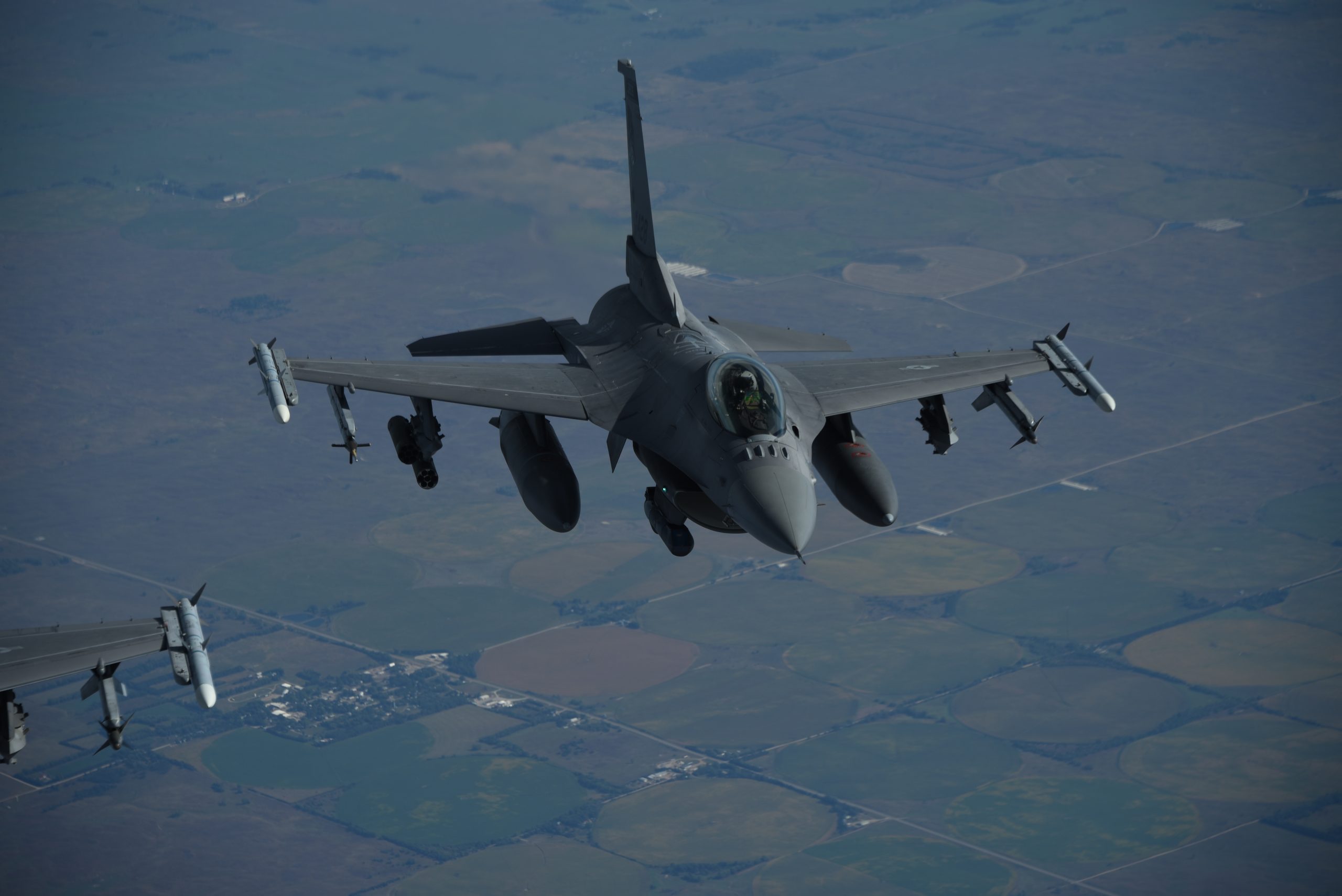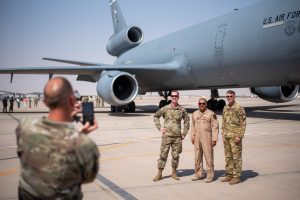
U.S. Air Force Col. Clinton Varty (left), 60th Maintenance Group commander, Brig. Gen. Akshai Gandhi (center), 378th Air Expeditionary Wing commander, and Col. Colin McClaskey (right), 821st Contingency Response Group deputy commander, pose for a group photo in front of a KC-10 Extender after an inactivation ceremony for the 908th Expeditionary Air Refueling Squadron at Prince Sultan Air Base, Kingdom of Saudi Arabia, Oct. 4, 2023. The ceremony highlighted the legacy of the KC-10 after over 30 years of service within the U.S. Air Forces Central (AFCENT) Area of Responsibility. By September 2024, the U.S. Air Force’s fleet of KC-10s will be decommissioned and gradually replaced by the KC-46 aircraft. (U.S. Air Force photo by Tech. Sgt. Alexander Frank)
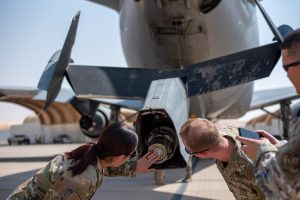
U.S. Airmen from the 378th Air Expeditionary Wing view the boom of a KC-10 Extender after an inactivation ceremony for the 908th Expeditionary Air Refueling Squadron at Prince Sultan Air Base, Kingdom of Saudi Arabia, Oct. 4, 2023. The ceremony highlighted the legacy of the KC-10 after over 30 years of service within the U.S. Air Forces Central (AFCENT) Area of Responsibility. By September 2024, the U.S. Air Force’s fleet of KC-10s will be decommissioned and gradually replaced by the KC-46 aircraft. (U.S. Air Force photo by Tech. Sgt. Alexander Frank)
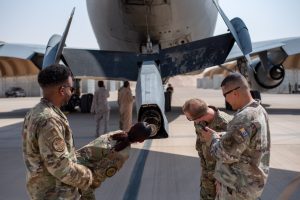
U.S. Airmen from the 378th Air Expeditionary Wing view the boom of a KC-10 Extender after an inactivation ceremony for the 908th Expeditionary Air Refueling Squadron at Prince Sultan Air Base, Kingdom of Saudi Arabia, Oct. 4, 2023. The ceremony highlighted the legacy of the KC-10 after over 30 years of service within the U.S. Air Forces Central (AFCENT) Area of Responsibility. By September 2024, the U.S. Air Force’s fleet of KC-10s will be decommissioned and gradually replaced by the KC-46 aircraft. (U.S. Air Force photo by Tech. Sgt. Alexander Frank)
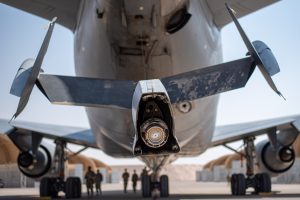
The boom of a KC-10 Extender sits on display after an inactivation ceremony for the 908th Expeditionary Air Refueling Squadron at Prince Sultan Air Base, Kingdom of Saudi Arabia, Oct. 4, 2023. The ceremony highlighted the legacy of the KC-10 after over 30 years of service within the U.S. Air Forces Central (AFCENT) Area of Responsibility. By September 2024, the U.S. Air Force’s fleet of KC-10s will be decommissioned and gradually replaced by the KC-46 aircraft. (U.S. Air Force photo by Tech. Sgt. Alexander Frank)
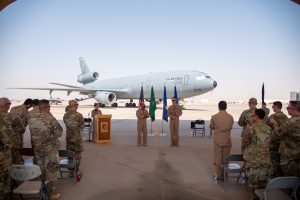
U.S. Airmen from the 378th Air Expeditionary Wing celebrate after an inactivation ceremony for the 908th Expeditionary Air Refueling Squadron at Prince Sultan Air Base, Kingdom of Saudi Arabia, Oct. 4, 2023. The ceremony highlighted the legacy of the KC-10 after over 30 years of service within the U.S. Air Forces Central (AFCENT) Area of Responsibility. By September 2024, the U.S. Air Force’s fleet of KC-10s will be decommissioned and gradually replaced by the KC-46 aircraft. (U.S. Air Force photo by Tech. Sgt. Alexander Frank)
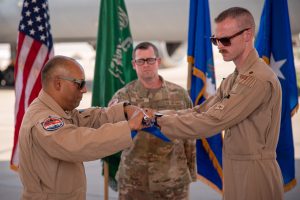
U.S. Air Force Maj. Joseph Rush (right), 908th Expeditionary Air Refueling Squadron (EARS) commander, and Brig. Gen. Akshai Gandhi (left), 378th Air Expeditionary Wing commander, roll-up the 908th EARS guidon during an inactivation ceremony at Prince Sultan Air Base, Kingdom of Saudi Arabia, Oct. 4, 2023. The ceremony highlighted the legacy of the KC-10 after over 30 years of service within the U.S. Air Forces Central (AFCENT) Area of Responsibility. By September 2024, the U.S. Air Force’s fleet of KC-10s will be decommissioned and gradually replaced by the KC-46 aircraft. (U.S. Air Force photo by Tech. Sgt. Alexander Frank)
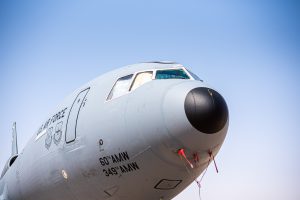
A KC-10 Extender sits on display after an inactivation ceremony for the 908th Expeditionary Air Refueling Squadron at Prince Sultan Air Base, Kingdom of Saudi Arabia, Oct. 4, 2023. The ceremony highlighted the legacy of the KC-10 after over 30 years of service within the U.S. Air Forces Central (AFCENT) Area of Responsibility. By September 2024, the U.S. Air Force’s fleet of KC-10s will be decommissioned and gradually replaced by the KC-46 aircraft. (U.S. Air Force photo by Tech. Sgt. Alexander Frank)
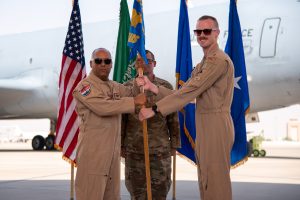
U.S. Air Force Maj. Joseph Rush (right), 908th Expeditionary Air Refueling Squadron (EARS) commander, passes the 908th EARS guidon to Brig. Gen. Akshai Gandhi (left), 378th Air Expeditionary Wing commander, during an inactivation ceremony at Prince Sultan Air Base, Kingdom of Saudi Arabia, Oct. 4, 2023. The ceremony highlighted the legacy of the KC-10 after over 30 years of service within the U.S. Air Forces Central (AFCENT) Area of Responsibility. By September 2024, the U.S. Air Force’s fleet of KC-10s will be decommissioned and gradually replaced by the KC-46 aircraft. (U.S. Air Force photo by Tech. Sgt. Alexander Frank)
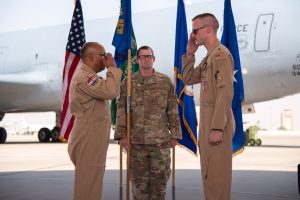
U.S. Air Force Maj. Joseph Rush (right), 908th Expeditionary Air Refueling Squadron (EARS) commander, salutes Brig. Gen. Akshai Gandhi (left), 378th Air Expeditionary Wing commander, prior to passing the 908th EARS guidon during an inactivation ceremony at Prince Sultan Air Base, Kingdom of Saudi Arabia, Oct. 4, 2023. The ceremony highlighted the legacy of the KC-10 after over 30 years of service within the U.S. Air Forces Central (AFCENT) Area of Responsibility. By September 2024, the U.S. Air Force’s fleet of KC-10s will be decommissioned and gradually replaced by the KC-46 aircraft. (U.S. Air Force photo by Tech. Sgt. Alexander Frank)
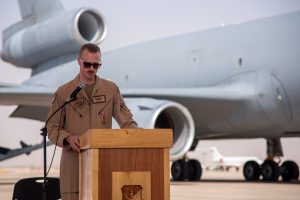
U.S. Air Force Maj. Joseph Rush, 908th Expeditionary Air Refueling Squadron (EARS) commander, delivers his final remarks as commander during the inactivation ceremony for the 908th EARS at Prince Sultan Air Base, Kingdom of Saudi Arabia, Oct. 4, 2023. The ceremony highlighted the legacy of the KC-10 after over 30 years of service within the U.S. Air Forces Central (AFCENT) Area of Responsibility. By September 2024, the U.S. Air Force’s fleet of KC-10s will be decommissioned and gradually replaced by the KC-46 aircraft. (U.S. Air Force photo by Tech. Sgt. Alexander Frank)
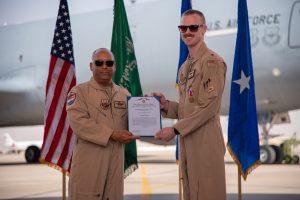
U.S. Air Force Brig. Gen. Akshai Gandhi (left), 378th Air Expeditionary Wing commander, poses for a photo after presenting Maj. Joseph Rush (right), 908th Expeditionary Air Refueling Squadron (EARS) commander, the Meritorious Service Medal during the inactivation ceremony for the 908th EARS at Prince Sultan Air Base, Kingdom of Saudi Arabia, Oct. 4, 2023. The ceremony highlighted the legacy of the KC-10 after over 30 years of service within the U.S. Air Forces Central (AFCENT) Area of Responsibility. By September 2024, the U.S. Air Force’s fleet of KC-10s will be decommissioned and gradually replaced by the KC-46 aircraft. (U.S. Air Force photo by Tech. Sgt. Alexander Frank)
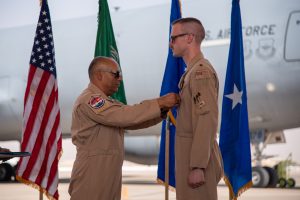
U.S. Air Force Brig. Gen. Akshai Gandhi (left), 378th Air Expeditionary Wing commander, pins a Meritorious Service Medal onto Maj. Joseph Rush (right), 908th Expeditionary Air Refueling Squadron (EARS) commander, during the inactivation ceremony for the 908th EARS at Prince Sultan Air Base, Kingdom of Saudi Arabia, Oct. 4, 2023. The ceremony highlighted the legacy of the KC-10 after over 30 years of service within the U.S. Air Forces Central (AFCENT) Area of Responsibility. By September 2024, the U.S. Air Force’s fleet of KC-10s will be decommissioned and gradually replaced by the KC-46 aircraft. (U.S. Air Force photo by Tech. Sgt. Alexander Frank)
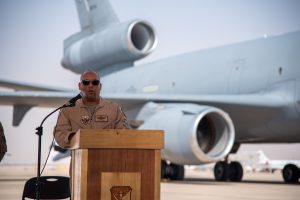
U.S. Air Force Brig. Gen. Akshai Gandhi, 378th Air Expeditionary Wing commander, delivers his remarks during the inactivation ceremony for the 908th Expeditionary Air Refueling Squadron at Prince Sultan Air Base, Kingdom of Saudi Arabia, Oct. 4, 2023. The ceremony highlighted the legacy of the KC-10 after over 30 years of service within the U.S. Air Forces Central (AFCENT) Area of Responsibility. By September 2024, the U.S. Air Force’s fleet of KC-10s will be decommissioned and gradually replaced by the KC-46 aircraft. (U.S. Air Force photo by Tech. Sgt. Alexander Frank)
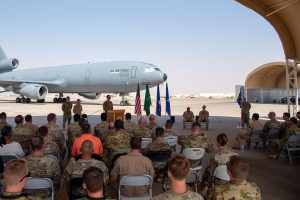
U.S. Airmen from the 378th Air Expeditionary Wing gather for the 908th Expeditionary Air Refueling Squadron’s inactivation ceremony at Prince Sultan Air Base, Kingdom of Saudi Arabia, Oct. 4, 2023. The ceremony highlighted the legacy of the KC-10 after over 30 years of service within the U.S. Air Forces Central (AFCENT) Area of Responsibility. By September 2024, the U.S. Air Force’s fleet of KC-10s will be decommissioned and gradually replaced by the KC-46 aircraft. (U.S. Air Force photo by Tech. Sgt. Alexander Frank)
